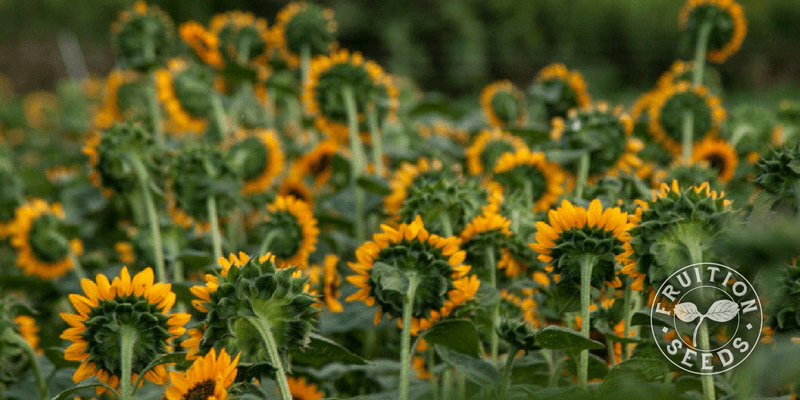When Heirloom Gardener asked me to write about the significance of regionally adapted seed for their Winter 2019 issue, the fact that such a story is of value to a nationally-distributed magazine gave me more than a sliver of hope for the world.
As a child in New York, I thought watermelons were an absolute waste of valuable garden space. I was a whimsical child, but still practical. With long, trailing vines yielding a single fruit and sometimes none, my anticipation was almost always unrequited. Every few years we’d give them another try, only to reach the same conclusion by September: We should have sown more tomatoes, more lettuce and more beets. Less watermelon.
I could not have been more wrong.
Like our reticent red peppers, eggplants lacking abundance, late-blooming dahlias and unenthusiastic peanuts, I simply needed different seeds to have different experiences. Sowing seeds adapted to your region makes all the difference.
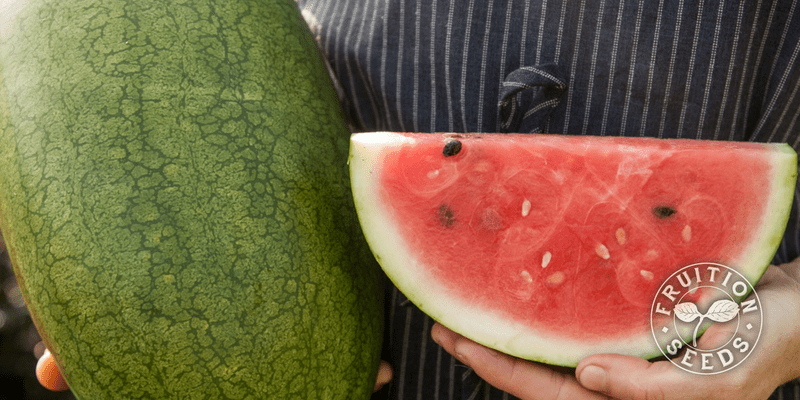
August Ambrosia is Fruition’s new watermelon, developed here in the Finger Lakes with Cornell, and it is our earliest and most productive watermelon, not to mention delicious…!
Local Seed is the Heart of Local Food
The oaks growing on my farm in the Northeast are very different from the oaks growing in California.
If regionally adapted oak seed makes a difference, why not lettuce? Tomatoes? Life on Earth depends on everything becoming better adapted, in fact.
Just as local food tastes better, gardening is easier and more abundant when the seeds you sow are regionally adapted to thrive in your region.
There is, perhaps, no seed more regionally adapted than those you save yourself.
In the meantime, there are many extraordinary stewards who save and share their passion, understanding and seeds with you.
But first, let’s put on a wider lens.
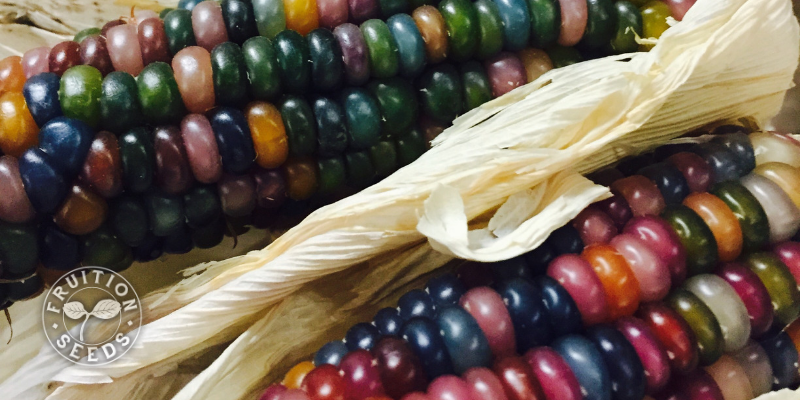
All open-pollinated varieties can be adapted to a bioregion, like this Glass Gem corn.
A Brief History of Seed
Each seed tells the story of an entire life history, millions of years in the making. A few seeds, in a single generation, may travel the globe. But most will stay within their watershed and, most likely, their microclimate. In this way, seeds become profoundly adapted to place.
Agricultural seed tells an additional story–one of human relationship. For the last 10,000 years, these seeds have slowly adapted to place, spreading first on our backs, then by camel, then by boat. Fast forward to 2019: most seed companies offer seed from all over the world. How did this happen?
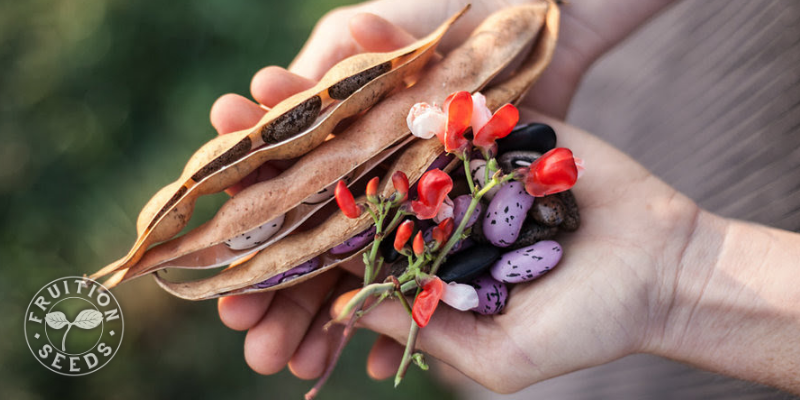
Chocolate runner beans are a favorite of ours as well as the hummingbirds.
From Commons to Commodity
If “regional seed” is seed adapted to a bioregion, then most seed before World War I was regional. Farmers in both industrialized and developing nations saved their own seed. Integral to their livelihood, farmers kept their prize bull for their herds and likewise excellent seedstock, well-adapted to their farms. Each generation selected varieties to meet the shifting conditions on each farm, in each region. Farmers largely would share their seeds as a commons, like clean water and fresh air, as precious resources to be honored and shared, not to be owned or restricted.
After World War I, F1 Hybrid corn was introduced. Met with resistance from wary farmers, the transition was slow but came to dominate the market within 40 years, due in large part to government subsidies in World War II. In a single generation, farm-grown seed was replaced by seed from other bioregions that would not grow true-to-type in future generations, if saved. As a result, seed became just another commodity, like fertilizers and pesticides, that all farms purchase annually.
Most of the seeds that grow the food in our grocery stores are owned and patented, their genes tightly controlled and restricted. These seeds are grown as an industrial, one-size-fits-all commodity, rather than a commons reflecting the unique values and needs of each region.
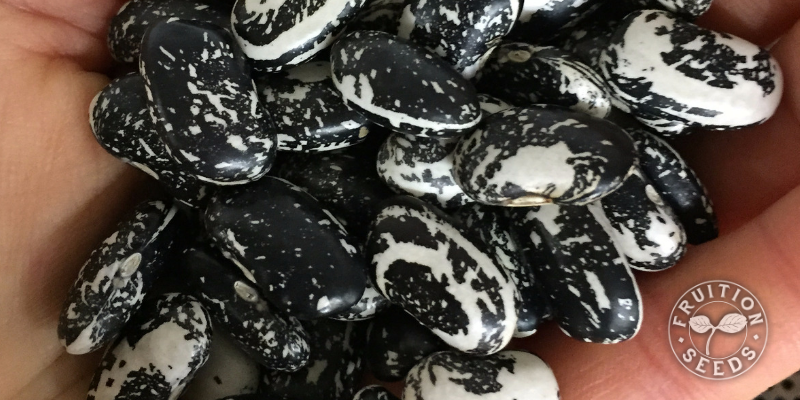
Sown Locally, Grown Globally
Most of us share a blind faith that our seed is produced by the companies selling them. This is most often not the case.
Today, most seed is grown where the climate favors commercial industrial dry seed production, such as the Central Valley of California. Unless you grow in the Central Valley, the seeds you sow are not likely to be well-adapted to your climate.
Much of this seed is adapted to modern agricultural techniques like mechanization, herbicides, pesticides and high yields from chemical fertilizers. Indeed, industrial food systems serve industry — business as usual — rather than regional, small-scale and organic markets.
Regionally Adapted…Peanuts?
In the Finger Lakes of Western New York, where I grew up in my father’s garden, there were nearly 100 seed companies in 1912. In 2012, when I founded Fruition Seeds in Western New York, there were three. Fruition was the only one growing any seed.
Fruition Seeds shares hundreds of varieties that thrive in the short seasons of the Northeast, plus the resources you need to surround yourself with abundance. All of the crops that matured way too late in my youth I now grow with ease, from our organic, regionally-adapted seeds. Red peppers, dahlias, watermelon, eggplant and countless ripe tomatoes are enjoyed each July instead of August, September or never. Even peanuts.
I received, in 2013, a gift of regionally adapted peanuts in the mail. I am not proud to admit, but I scoffed with skepticism. My family grew peanuts once when I was a child. Though fun and easy to grow, we vowed to never waste four months of gardening to harvest five peanuts again. Nonetheless, we sowed these seeds, from a man who had selected them, painstakingly, in the Upper Peninsula of Michigan for over 30 years. That was 2013, the coldest season on record in our county, and we harvested an average of 21 peanuts per plant. In 2016, the warmest on record, we harvested an average of 41. Yes, even peanuts can become regionally adapted, with enough time, human imagination and the potential of genetic diversity.
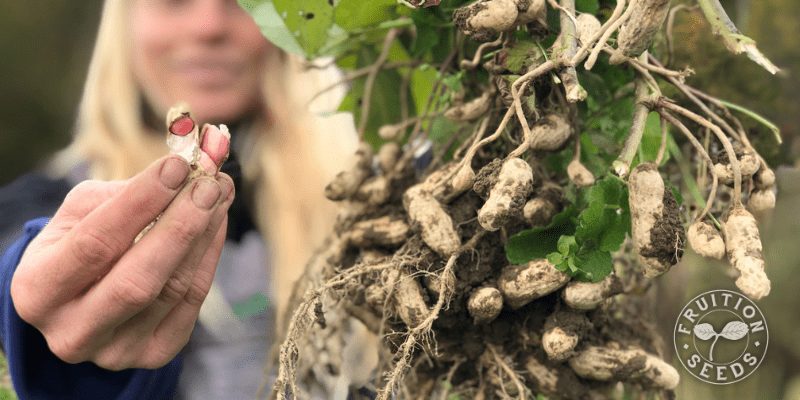
Northern Hardy Valencia Peanuts are surprisingly productive, even in short seasons.
Where to Find Regionally Adapted Seeds
Here is the bad news: Regionally adapted seed is hard to come by. You likely have a seed company within 500, perhaps even 100 miles of you. Most seed companies are distributors of seed rather than growers of seed, making much of the seed on the planet regionally adapted to the long, dry climates where seed is commercially grown rather than where a gardener might sow it.
The good news is this: We can always ask questions, so call seed companies. Ask them where their seeds are sourced, where they’re grown, what they’re selected for. A seed company worth supporting will answer these questions and be delighted you asked.
More good news: There are more and more of these companies each year.
Here are just a few of those companies:
Fruition Seeds
Naples, New York
Our organic seeds reflect what we love about life, as well as what we need to thrive in short seasons: Cold-hardy kale, spinach and cilantro that overwinter uncovered in our gardens, delicious tomatoes that ripen early and are disease-resistant, flowers that feed our bodies, souls and native pollinators. We celebrate regional heirlooms, like our rich and creamy Sibley winter squash, introduced in Rochester in 1888. We also develop new varieties that our grandchildren will know as beloved heirlooms, like our August Ambrosia watermelon that we harvest in late July and all through August. Many of our varieties are developed at nearby Cornell University, like the Silver Slicer cucumber, which we love for incredible flavor as well as resistance to powdery mildew.
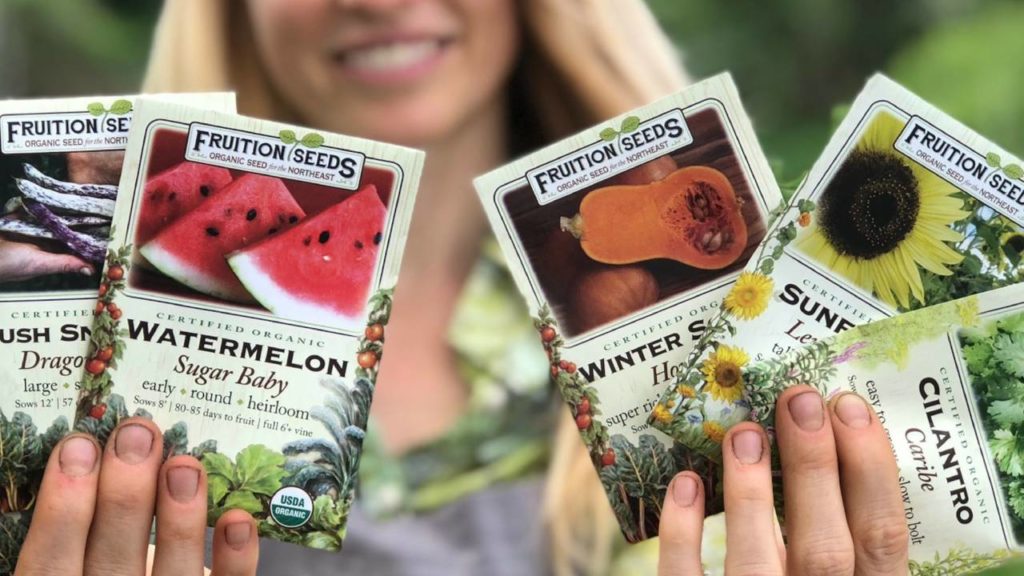
We also love sharing everything we’ve learned in our decades of organic gardening in Zone 5. Fruition’s blog, social media and YouTube channels are invaluable resources for home gardeners; Flourish Garden Club is our in-depth garden community, with hundreds of members and immense resources for beginning and experienced gardeners alike. Our online courses share the deepest step-by-step instructions and inspiration to build your skills, confidence and community. Hope to see you on the farm one day for our farm store, a farm tour and a tasting, too!
CommonWealth Seeds
Louisa, Virginia
“If we want seeds that work well for Southeast growers, we have to do this work in the Southeast,” muses Edmund Frost, founder of Common Wealth Seeds. Edmund’s variety trials are impressive. He also produces quality seed, preserving regional heirlooms, as well as developing new varieties well-suited for the Southeast. “These seeds are essential,” says Edmund, “and so is the work of creating strong community to empower and enrich us all.”
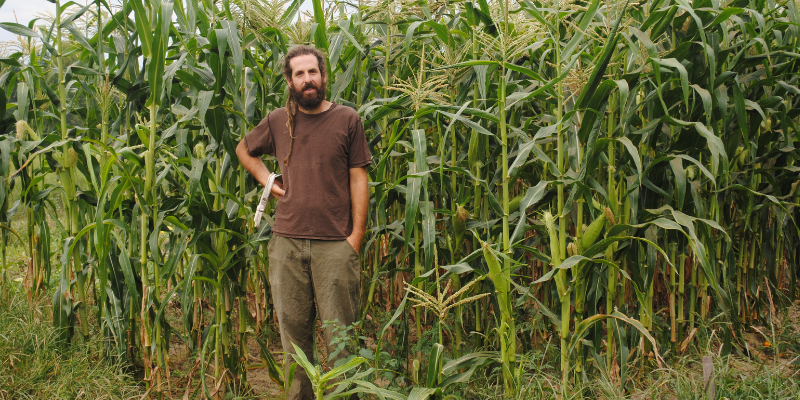
Edmund has just released “South Anna,” a butternut that grows better than any other available in the Southeast. “We crossed ‘Waltham’ butternut and ‘Seminole’ pumpkin, a variety native to Florida,” explains Edmund. “I’ve selected South Anna for flavor and productivity as well as pest and resistance to downy mildew.”
Edmund selects for remarkable traits while maintaining genetic diversity, and thus adaptability, in his varieties. His seeds are thriving, all over the South, from home gardeners to large-scale growers to university trials.
Nature and Nurture Seeds
Ann Arbor, Michigan
“Here in the Heartland, summers are hot, humid and short while winters are long and cold,” describes Erica Kempter, co-founder of Nature and Nurture Seeds. “Rooted in southeast Michigan’s rich prairie soils, we passionately preserve Midwest heirloom seeds, cultivate community and create new regionally-adapted varieties.”
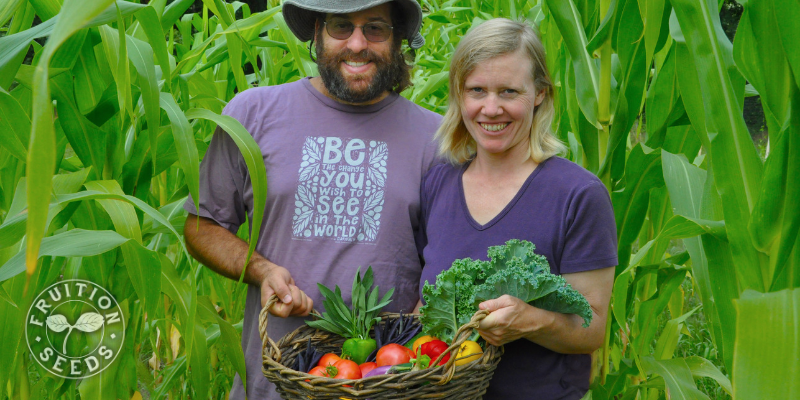
‘Grand Rapids’ lettuce is a perfect example. With frilly, sweet neon green leaves, it’s an heirloom adapted to Grand Rapids, Michigan, from over a century ago.
“Grand Rapids lettuce celebrates the Midwest’s past with exciting promises for the future,” beams Erica. In 1900, this variety was introduced in Grand Rapids, Michigan to grow in the extreme cold of unheated glass-houses, supplying millions of pounds of winter lettuce to the region. “We continue to adapt it,” says Erica, “by growing it in unheated hoop-houses through even the harshest polar vortex winters (-6 F), then saving seeds from surviving plants.” Nature and Nurture has also crossed Grand Rapids lettuce with a red lettuce, creating a rainbow of cold-hardy, regionally adapted lettuces for this and all future generations.
Snake River Seed Cooperative
Boise, Idaho
“Our mission is to grow a robust regional seedshed for the Intermountain West,” proclaims the vivaciously contagious Casey O’Leary, founder of Snake River Seed Cooperative. “For us, this means building a network of farmers, gardeners, breeders and eaters who value locally produced seeds and the resilience, abundance and independence they bring to our region.”
Casey has an impressive collection of seed adapted for her region. She is particularly passionate about ‘Payette,’ a delicious, stocky, early slicing tomato with resistance to curly top virus. “Payette was bred by the University of Idaho in the 1960s and it’s one of our favorite Idaho-bred varieties.”
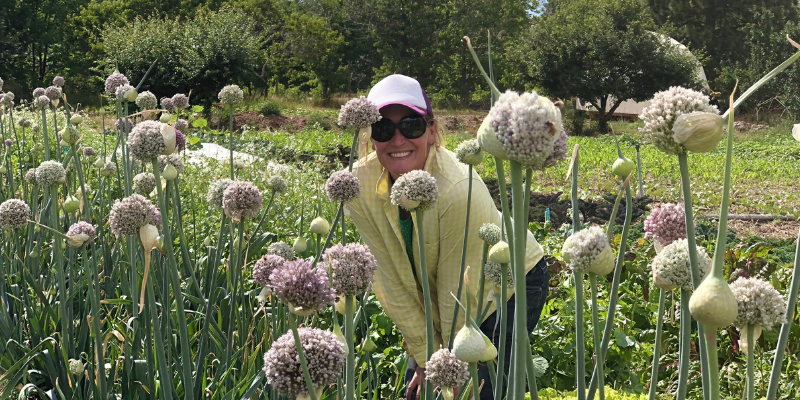
‘Advent Gulch Blue Corn’ also represents and celebrates the Intermountain West. Mike O’Brien has developed this corn over 40 years, selecting for exceptional cold-soil germination and emergence, as well as early maturing cobs. Mike has deliberately kept flour, flint, dent, and even a few sweet corn kernels in the variety. “Advent Gulch Blue Corn makes a delicious cornbread and has performed well in our tortilla trials, too,” says Casey, her smile convincing.
Casey also carries an extensive selection of wildflowers native to the Intermountain West to feed native pollinators.
Sow What You Love, Love What You Sow
Seeds are gifts, the creative genius and legacy of our ancestors, plant and human alike. It is our responsibility to care for them, sharing their cultural and agricultural abundance, for generations of all species to come.
May the seeds you sow this season transform and amplify the immense adaptation and abundance possible on our planet.
Sow Seeds & Sing Songs,

and the Many Beings of Fruition
ps
The article includes a map of regionally adapted seed companies! It’s not the clearest to see in the photo, so I’ve shared the full list below.
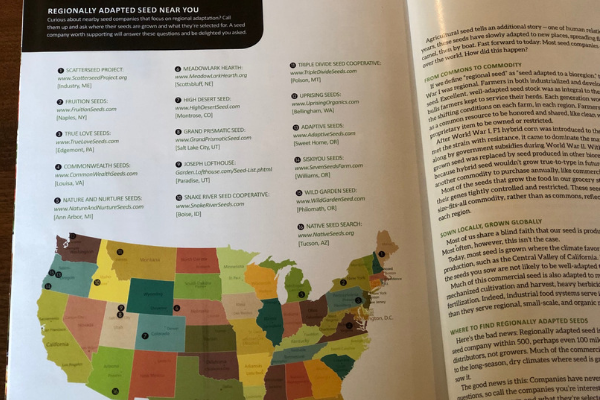
Scatterseed Project (Maine): https://www.scatterseedproject.org/
Commonwealth Seeds (Virginia): http://commonwealthseeds.com/
Joseph Lofthouse (Utah): http://garden.lofthouse.com/seed-list.phtml
Nature and Nurture Seeds (Michigan): https://natureandnurtureseeds.com/
High Desert Seed (Colorado): http://www.highdesertseed.com/
MeadowLark Hearth (Nebraska): http://www.meadowlarkhearth.org/
Prairie Road Organic Seed (North Dakota): https://www.prairieroadorganic.co/
Grand Prismatic Seeds (Utah): https://www.grandprismaticseed.com/
Snake River Seed Cooperative (Idaho): http://snakeriverseeds.com/
Triple Divide Seed Cooperative (Montana): https://tripledivideseeds.com/
Uprising Seeds (Washington): https://uprisingorganics.com/
Adaptive Seeds (Oregon): https://www.adaptiveseeds.com/
Siskiyou Seeds (Oregon): http://www.sevenseedsfarm.com/
Wild Garden Seeds (Oregon): https://www.wildgardenseed.com/
True Love Seeds (Philadelphia): https://trueloveseeds.com/
Joseph Lofthouse (Utah): http://garden.lofthouse.com/seed-list.phtml
Native Seed SEARCH (Arizona): https://www.nativeseeds.org/
